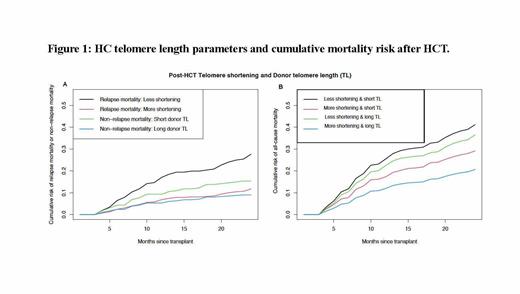Introduction. Telomere length (TL) reflects cell replicative history and residual replicative potential. Telomeres in donated hematopoietic cells (HCs) shorten considerably after hematopoietic cell transplant (HCT) because of the extensive proliferation required to reconstitute the recipient hematopoietic system. Longer telomeres in donor HCs are associated with better survival post-HCT in patients with severe aplastic anemia (Gadalla et al., JAMA 2015; Blood 2018). However, it is unclear whether donor HC TL affects survival of patients receiving HCT for hematological malignancies.
Methods. We identified 384 patients with leukemia or myelodysplastic neoplasms who received HCT between 2013 and 2016 at 1 st complete remission/early disease stage, and had post-HCT blood samples at day 90 (standard deviation: SD=14 days) in the Blood and Marrow Transplant Clinical Trials Network (BMT CTN) protocol 1202 repository. Pre-HCT matched donor samples were available at the Center for International Blood and Marrow Transplant Research (CIBMTR) biorepository. TL was measured by Southern blotting of the terminal restriction fragments. We used Cox proportional hazard models to evaluate the associations between HCT outcomes and (i) long donor HC telomeres (defined as ≥6.7 kb), and (ii) low post-HCT telomere shortening of donor HC TL (defined as <230 bp and calculated as the difference between pre-HCT donor HC TL and that in the recipient post-HCT). The telomere thresholds were determined by exploratory analyses relating HC TL parameters with recipients' outcomes. Study outcomes are 2-year overall survival (OS), relapse risk, and non-relapse mortality (NRM). We also calculated the adjusted cumulative risks of all-cause and cause-specific mortality associated with the two HC TL parameters using cause-specific competing risk methods. Follow-up started at day 100 post-HCT.
Results. Patients' mean age was 49.6 years (SD=18) and that of the donors was 37.9 years (SD=15). About half (54.7%) of the patients received HCT from unrelated donors, and 9% from haplo-identical related donors. The 2- year OS probabilities were higher in patients receiving HCT from donors with HC TL ≥6.7 kb compared to those receiving HCT from donors with HC TL below this threshold (76% and 63%, respectively; p log-rank = 0.009). Similarly, recipients with telomere shortening of donated HCs ≥230 bp post-HCT compared with those below this threshold experienced better 2-year OS(78% and 62%, respectively; p=0.003). These associations remained significant after adjusting for donor age and predictive clinical factors (HR= 0.60, p = 0.03 for donor HC TL ≥ vs. < 6.7 kb; and HR = 1.95, p = 0.003 for donated HC telomere shortening post-HCT below vs. ≥ 230 bp).
The leading cause of excess mortality differed by HC TL parameters. Donor HC TL of ≥6.7 kb was associated with lower risk of NRM (HR= 0.45, 95% CI = 0.22 - 0.93, p = 0.03; 2-year NRM risk of 9.0% vs. 15%). However, post-HCT telomere shortening of <230 bp was associated with higher risk of relapse (HR=1.82, 95% CI = 1.11 - 1.82, p=0.02; 2-year relapse-mortality risk of 28% vs. 12%) (Figure 1A). When considering the combined effect of donor HC TL and magnitude of TL shortening in recipient, the adjusted cumulative risk of all-cause mortality dropped in half (from 41% in patients with donor HC TL <6.7 kb and telomere shortening <230 bp to 21% in those with donor HC TL ≥6.7 kb and telomere shortening ≥230 bp (Figure 1B)
Conclusions. Short telomeres in donated HCs and their limited telomere shortening after HCT are associated with poor survival in patients receiving HCT for hematological malignancies at 1st complete remission/early disease stage. The study suggests that TL in donors prior to HCT may be a useful marker for improved donor selection independent of age. Less HC telomere shortening in the recipients during the first 90 days might identify patients at higher risk for relapse of hematological malignancies.
Disclosures
Levine:Incyte: Consultancy; Inhibrx: Consultancy; Kamada: Consultancy; Mesoblast: Consultancy; Sanofi: Consultancy; X4 Pharmaceuticals: Consultancy; Genentech: Research Funding; Incyte: Research Funding; Mesoblast: Research Funding; Viracor: Patents & Royalties: GVHD biomarker patent.; Equillium: Consultancy; Editas: Consultancy; Bluebird Bio: Consultancy.


This feature is available to Subscribers Only
Sign In or Create an Account Close Modal